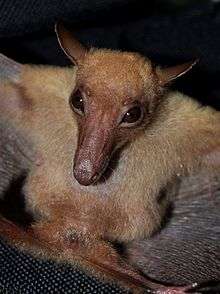Long-tongued fruit bat
The long-tongued fruit bat (Macroglossus sobrinus) is a species of megabat. It is nectarivorous, feeding on nectar from primarily banana flowers. It is found in several countries in South and Southeast Asia.
| Long-tongued fruit bat | |
|---|---|
 | |
| Scientific classification | |
| Kingdom: | Animalia |
| Phylum: | Chordata |
| Class: | Mammalia |
| Order: | Chiroptera |
| Family: | Pteropodidae |
| Subfamily: | Macroglossinae |
| Genus: | Macroglossus |
| Species: | M. sobrinus |
| Binomial name | |
| Macroglossus sobrinus K. Andersen, 1911 | |
 | |
| Long-tongued fruit bat range | |
| Synonyms | |
| |
Taxonomy and etymology
It was described as a new subspecies in 1911 by Danish mammalogist Knud Andersen. Andersen described it as a subspecies of the long-tongued nectar bat, with the trinomen Macroglossus minimus sobrinus.[2] Beginning in approximately 1983, it has been considered a full species rather than a subspecies.[3] Its species name "sobrinus" means "cousin;" Andersen possibly chose this name to reflect what he believed was its close relationship to M. minimus minimus.
Description
Andersen noted that it differed from the long-tongued nectar bat in several ways. Overall, it is a larger species with a longer snout. Its forearm is 42–48.5 mm (1.65–1.91 in) long.[2] Individuals weigh 18–26 g (0.63–0.92 oz).[4]
Biology and ecology
It is nectarivorous, feeding on the nectar of flowers. It consumes nectar almost exclusively from banana flowers. It is nocturnal, foraging at night and roosting during the day in trees. When roosting during the day, it roosts singly or in small, "well-spaced parties."[4]
Range and habitat
Unlike the long-tongued nectar bat, which is considered a coastal species, the long-tongued fruit bat is considered an inland species.[4] Its range includes several countries in Asia, including Cambodia, China, India, Indonesia, Laos, Malaysia, Myanmar, Thailand, and Vietnam.[1]
Conservation
It is currently assessed as least concern by the IUCN—its lowest conservation priority. It meets the criteria for this classification because it has a large geographic range; its range includes protected areas; it tolerates some human-mediated landscape changes, and its population is thought to be stable.[1]
References
- Hutson, A.M.; Suyanto, A.; Kingston, T.; Bates, P.; Francis, C.; Molur, S. & Srinivasulu, C. (2008). "Macroglossus sobrinus". The IUCN Red List of Threatened Species. 2008: e.T12595A3363666. doi:10.2305/IUCN.UK.2008.RLTS.T12595A3363666.en.
- Andersen, K. (1911). "LXXV.—Six new fruit-bats of the genera Macroglossus and Syconycteris". Journal of Natural History. 8. 7 (42): 641–643. doi:10.1080/00222931108692987.
- Hill, J. E. (1983). Bats (Mammalia: Chiroptera) from Indo-Australia. British Museum (Natural History).
- Marshall, Adrian G (1983). "Bats, flowers and fruit: Evolutionary relationships in the Old World". Biological Journal of the Linnean Society. 20: 115–135. doi:10.1111/j.1095-8312.1983.tb01593.x.
